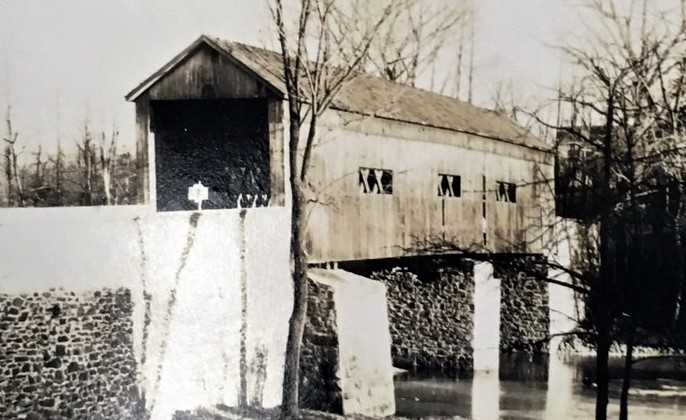The demise of a Bucks County treasure helped spark a movement to save others.
It has been a tradition in the family to spend joyous hours exploring the upper section of Washington Crossing Historic Park in Solebury. The state’s premier wildflower preserve, woodland trails, a spring-fed pond, swift-moving Pidcock Creek, an operational grist mill, a fieldstone mansion that once served the Continental Army, a 397-foot-high mountain with a lofty watchtower you can stand atop, a burial ground for Revolutionary War soldiers, the Delaware Canal, towpath trail and the Delaware River – all close at hand.
The only thing missing is a covered bridge. The state moved it years ago. Then it disappeared. The story of the Neely Mill Bridge over Pidcock Creek is a sad one and marked the beginning of a movement to save others throughout the nation.
Once upon a time in Bucks County, covered bridges were ubiquitous. There were more than 50 of them built in the 1800s to link the county’s road network to all the towns. In 1919 the state took control of at least 40 of the bridges dating to 1820. In 10 years, it replaced many with cement and steel spans. They included those in Lower Southampton, Northampton, New Britain and Nockamixon.

Preservationists sounded the alarm in 1929 when Harrisburg announced Neely’s Mill Bridge on River Road in Solebury would be the next to fall to give the area “a more colonial look”. The bridge happened to be one of the most scenic and historic in Bucks. Perched high over the creek at the base of Bowman’s Hill, it overlooked the ancient Thompson-Neely Grist Mill on one side, and a fieldstone mansion on the other where officers of the Continental Army were headquartered before George Washington’s famous Christmas crossing of the Delaware River to capture Trenton in 1776. The bridge, built about 45 years after the crossing, was remarkably beautiful in its setting.
When plans to remove it bubbled up, local citizens fumed. Are you kidding? At such an historic site? The newly-formed Delaware Valley Protective Association lodged a vigorous protest. Highway officials insisted a modern “historically correct stone arch” replica was needed. To avoid a public relations fiasco, the state agreed to relocate the old bridge to a designated field inside the new park to become a visitor attraction. After moving it 1,000 feet in 1935 however, the state abandoned the effort. Vandals soon took control. In 1939, the Bucks County Federation of Women’s Clubs sighed, “Here we had the best known of all county bridges. This is due to the fact of its location near a historic spot that through the ages has become famous. An attempt was made to preserve the bridge when removed in 1935, but now we find only the skeleton of the structure standing in a nearby field. It is entirely doomed.”
The federation pleaded with officials to protect remaining covered bridges. The situation drew increasing national attention that same year when county government decided to demolish the South Perkasie Covered Bridge built in 1832. Local citizens became frantic. Andy Schuler begged the county to save it, move it to nearby Lenape Park. The local Kiwanis Club took a different tact, convincing the county to rehabilitate the bridge. By 1956 however, its condition had deteriorated and was condemned at the request of the Perkasie town council.

By then, public sentiment to preserve covered bridges had grown considerably. Covered bridge tours by automobile had become a neat thing to do. The impending demise of another historic span fanned wide opposition. Perkasie’s historical society announced it would campaign to move the bridge to Lenape Park as Andy Schuler earlier had recommended. The Delaware Valley Protective Association joined in, raising enough cash to pay for the move. In July 1958, an Associated Press photo of the bridge being relocated appeared on newspaper front pages all over the country.
The years passed. Out of more than 12,000 covered highway bridges built in the U.S. since the 1800s, only 1,000 now remain. Pennsylvania has the most with 197. Today the South Perkasie Covered Bridge is a municipal icon. It’s among just 12 covered spans left in Bucks. They’re beloved treasures and symbolic of the county’s heritage. When threatened or damaged, they’re quickly restored. After fire destroyed Mood’s Covered Bridge in East Rock Hill Township in 2004, citizens rebuilt it and reopened it to traffic on Blooming Glen Road. Similarly, arsonists torched the Schofield Ford Covered Bridge over Neshaminy Creek in Newtown Township in 1991. It too was rebuilt and is favored by hikers, cyclists and equestrians in Tyler State Park.

My family loves to visit covered bridges whenever possible. It’s a unique experience to see the work of our great, great, great grandfathers and spend time exploring creeks below while projecting ourselves back to the Tom Sawyer in each of us.
***
Sources include “How Bucks County lost and then saved its covered bridges” on the website of Preserving Perkasie; “Perkasie Residents Act to Preserve Covered Bridge Condemned by County” published on March 5, 1958 in the Morning Call (Allentown) newspaper, and “Planners Urge Preserving Bucks Covered Bridges” published on March 8, 1958 in the Bristol Daily Courier. Descriptions of each of the county’s 12 remaining covered bridges can be found on the web at www.scenicbuckscounty.com/CoveredBridges/CoveredBridges.html

